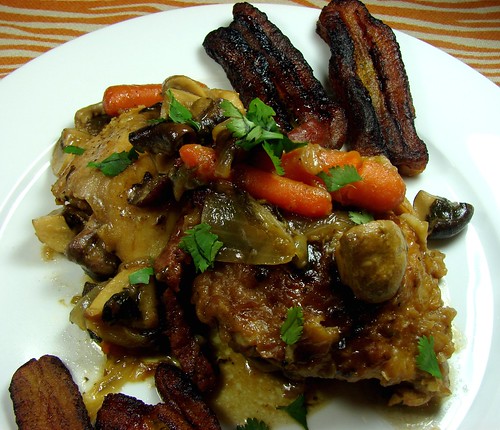Do you believe soups are better suited for a specific time of the year? Maybe when it is cold and dreary or rainy outside? For Panamanians, soup is on any day of the week and year. As a matter of fact, you’ll find it on the daily lunch menu at every restaurant or Fonda around the country.
When I was in Austin a few weeks ago, I saw an advertisement for Sopa de Arroz con Pollo (Chicken & Rice Soup). Even though I’ve heard about chicken & rice soup, I never really thought about it in a Latin context until then. Chicken & rice soup doesn’t move me in any way, but Sopa de Arroz con Pollo…? Now, that’s a completely different matter. I simply couldn’t get it off my mind. The possibilities. The potential goodness. Muy rico.
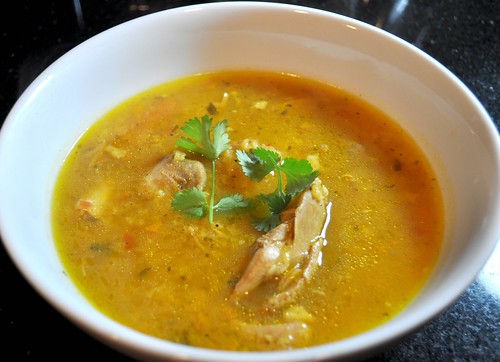
It turned out lighter than I had anticipated, even with the addition of the rice. Rich with the flavors of the chicken broth and culantro. I didn’t have any yuca at home, but next time I make it, I will use that instead of potatoes. And it was a breeze to make too!
Sopa de Arroz con Pollo
1-1/2 lbs of chicken on the bone (I prefer thighs) seasoned with 2 pkts Sazón Goya .
To your blender, add 1/2 onion, 1/2 red bell pepper, 1/4 cp cilantro or 3 culantro leaves and 2 crushed garlic cloves, add just enough water to puree all the ingredients; I ended up with about 3 cps of puree.
Put the seasoned chicken and the puree in a stockpot over medium-high heat and allow it to cook for about 10 minutes, stirring occasionally. This will allow the flavors from the pureed veggies to infuse the chicken before adding all the water for the soup.
After about 10 minutes, add enough water to totally submerge the chicken, about 6 cps, add some chopped potatoes and carrots, season with salt & pepper, and 1 bay leaf. Bring it all to a boil, then lower temperature to allow it to simmer and cook for about 20-30 minutes or until the chicken is tender.
Remove the chicken from the broth and add 1/2 cp of rice to it, allow it cook while the chicken cools enough to remove the bones. Make sure to stir the broth every few minutes, making sure to remove any rice that may stick to the bottom. In the meantime, chop the chicken, if you’d like and return it to the broth. Cook just long enough for the rice to soften.
Serve in bowls and enjoy!
Cookingly yours,
Anamaris
I love learning new things, especially new cooking things. Be it techniques, flavors, ingredients, I love it. The world is so full of delicious and unique goodies, we would need to live several lifetimes in order to appreciate them all. There is a flower/plant that is very popular in Panama, the Caribbean and Mexico. In Panama and the Caribbean it is known as Saril or Red Sorrel. In Mexico, they call it Flor de Jamaica (Jamaican flower) and they use it for their aguas frescas–essentially, flavored (infused) waters.
These next 3 shots were taken by Peter, Mr. P. de Panama. A US expat living in my little country, who kindly allowed me to use his shots in exchange for the link to the recipe featuring them. I think I got the best end of that deal. Definitely take some time to visit his Flickrstream, he has some awesome photos here.
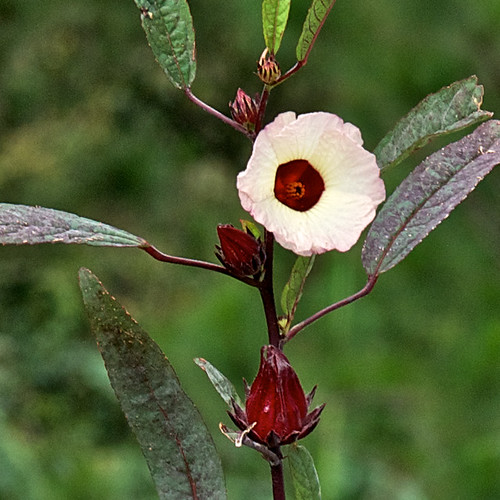
Saril bush, flower and ...the thing you make the juice with
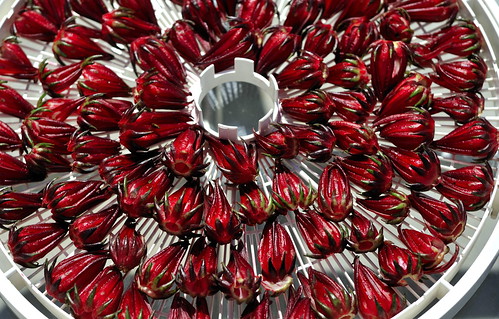
Similarly, I’ve been drinking Ponche de Saril (Saril punch) since I was a little kid; my mom and aunts would sit around for hours piting the flowers, then they would steep them with lots of ginger. To serve it, sugar and sometimes lime juice was added and then the drink is poured over lots of ice. It is one of the most beautiful and refreshing things you’ll ever drink, an awesome combination of tartness and zing. My mouth is watering just thinking about it.
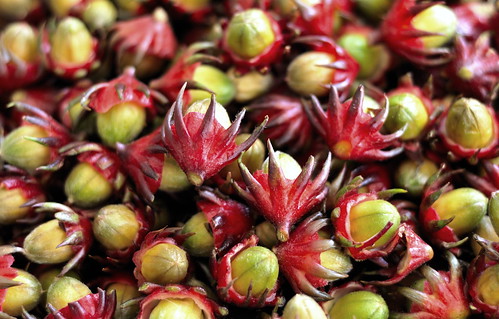
the pits!
That was the only use I was aware of for this flower, a relative of the common hibiscus plant. Recently, I read a post by one of my fave foodies, Lesley over at The Mija Chronicles. She used the reconstituted flowers to make quesadillas, then I discovered she has a fascination with the little flower and has prepared and eaten many dishes incorporating it. To say I was intrigued does not cover it. I couldn’t get it out of my mind. The possibilities seemed endless once I realized the genius of exploiting the flavors of the miracle flower. What to do…?
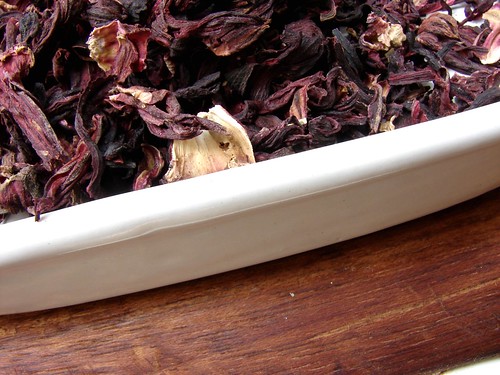
As you can see, the flower is a bright purplish red, the color intensifies when dried. The liquid, broth, tea, water, whatever we should call it, is a beautiful ruby red, a bit more intense than the color of cranberry juice. I wanted to make sure that the dish I created continued to pay homage to the vibrancy of the flower’s color. Saril’s flavor profile could be compared to that of fresh cranberries, I guess. Except, not as tart, giving way to a slight sweetness along the way. Again, I needed to preserve those flavors in the final product: chicken would open itself up to the flavors. A bit of heat and we would be golden. Want to see?
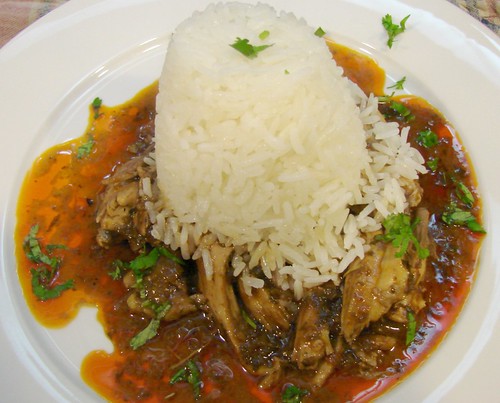
Chicken in Saril and Ancho Sauce
For the chicken
1 whole chicken, cleaned
2 carrots, halved
1/2 cilantro bunch
4 cloves garlic, whole
1 tbsp Herbs d’Provence
1 tbsp sea salt
Water
Remove the innards from the bird’s cavity and rinse the chicken under cold tap water. Place all the ingredients, except for the chicken and water in a stockpot, rest the chicken over them, then fill the pot with enough water to completely cover and submerge the chicken. Place on the stove on high heat until it comes to a boil. Once it boils, lower the temperature just enough to keep it at a slow boil (about medium-high flame) and allow it to cook for another 20 minutes.
At the end of the 20 minutes, turn off the heat and cover with a tight-fitting lid. Let it steam for another 30-45 minutes. Remove the chicken to cool and reserve the broth. This will result in the most beautiful, flavorful, moist chicken meat ever and the broth is amazing. Once the chicken has cooled, break the chicken into pieces and remove the meat from the bones into bite-size pieces. Set aside.
For the sauce
2 cps reserved broth
2 ancho chilies, whole
2/3 cp dried saril
2 tbsp raspadura or dark brown sugar
1-2 tbsp olive oil
1 yellow onion, diced
2 cloves garlic, finely chopped
1/2 cp cilantro, chopped
1 tbsp flour
1/2 cp heavy cream, approx
Reserved chicken broth
Sea salt & black pepper
Place the raspadura, anchos and saril in a small pan with about 2 cps of the chicken broth, bring it to a slow boil for about 10-15 minutes, just until the chilies have softened. Puree in the blender until smooth.
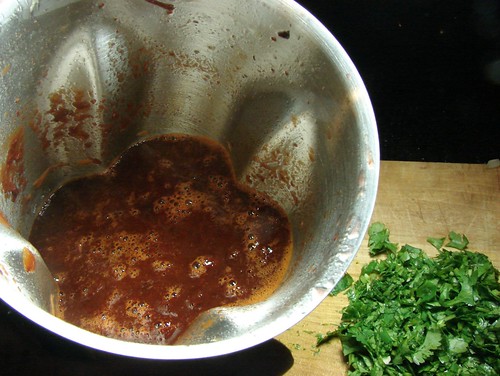
Heat a pan large enough to hold all of the chicken meat and add the olive oil, onions and garlic, cook until the onions are soft and translucent. At this point add the cilantro then the flour and stir constantly over medium heat, don’t let the flour burn, this will help thicken the sauce later. Add the saril puree and enough broth to make the sauce runny, about the consistency of half & half.

Once the sauce thickens a bit, to about the consistency of heavy cream, stir in the cream then add the chicken and lower the temperature to a slow simmer. Allow it to cook for 20-30 minutes, long enough for all the flavors to come together. Serve over white rice, maybe even pasta and be ready to be oh so happy!

To see just a few more pictures of the cooking goodness, go to my Flickr stream, here. Don’t forget to stop by Peter’s page while you’re there. Mil gracias, Pedro!!!
Cookingly yours,
Anamaris
Even though Mexican food is readily available in Houston, that doesn’t mean you get good tamales. For years I enjoyed the Rolls Royce of tamales, but most restaurants here serve tamales that are closer to a Yugo. My ex-mother-in-law made the best tamales I’ve eaten to date. She made them every year and would give each of her sons a few dozens to enjoy. I cherished those days, they only came around once or twice a year, so I had a lot of time to think and dream about them. Alicia was a generous woman, but she kept her method and recipe for tamales very close to the vest. Fast forward some 15 years, you’ll find me trying my hand at recreating the coveted tamales.

Off to the interworld I went looking for recipes and tips. I found lots and lots of them, all calling for chili powder as seasoning. For some reason, I can’t picture my mother in law dumping chili powder to season her pork or chicken. So, I’m going to make this up as I go, combine some of the ingredients I saw her utilize in other dishes and see what happens. It all begins with the chilies. I used 3 different dried chiles:
- Chile Ancho is pretty mild by comparison to other dried peppers, it has a smoky fruity flavor. This isn’t surprising when you realize that Anchos are dried red poblano peppers.
- Chile Guajillo also a mildly flavored chile, that seems to bring out the best in its companions. Fruity, but with sweeter undertones than other peppers. Interestingly, guajillos are also used to make Harissa paste, a condiment popular in North African dishes.
- Chile Pasilla are very dark and wrinkled like a raisin, they’re also pretty mild heat & fruity.
I used all three chilies a few different ways. First, to braise the pork and chicken. Yes. I made 2 different types of tamales, I had to. Both meats were cooked separately and slowly with onions, garlic, cumin, cilantro and 1 or 2 of each chili. I made sure to add plenty of water for braising, because that very broth flavors the masa later. Once the meat is fork tender, I allowed it cool before shredding.

I also made additional chili sauce. One thing I remember about Alicia’s tamales, is that the dough was always very flavorful and colorful. For the chili sauce, I cooked the same aromatics: cilantro, chilies, onions, garlic, cumin and added tomatoes. Once everything had softened, I pureed and seasoned the sauce.

Now let’s talk about the masa. I opted to use premixed masa instead of starting off with the dry corn stuff. But first I made lard. Yep, there’s a LOT of lard in tamales. The lard helps flavor the masa and makes it lighter, fluffier. So, I got some pork fat trimmings and rendered that fat down.
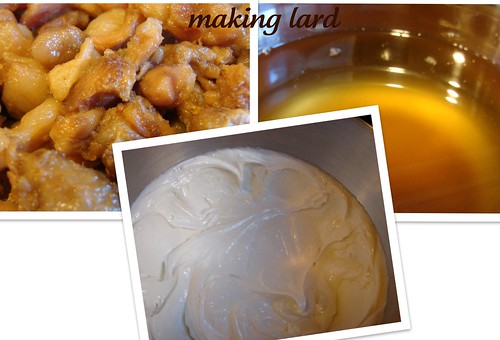
Before combining the lard and masa, I beat the lard until it was fluffy and added salt, pepper and pinch of cumin. I then worked the masa in and worked on its consistency by adding chile sauce and broth until it was about the consistency of softened ice cream.
The tamales are cooked in corn husks, these are sold in packs and need to be rehydrated before use. Once they are pliable again, you can begin the exciting task of stuffing or making the tamales. Its not a difficult process, but it is a tedious one, which is probably why it is customary to have a few friends or family members pitch in at this point.
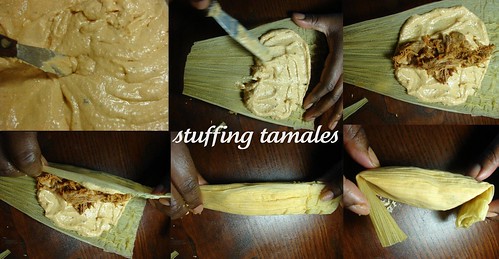
Once your tamales are stuffed, you can stack’em into a steamer pan. I took a vegetable steamer and placed it at the bottom of the pan, built a few layers with empty corn husks, this prevents the water from seeping through and ruining the tamales at the bottom and it also add to the flavor of finished tamales.

After about 40 minutes, you’ll end up with perfectly cooked, delicious tamales. Look at that gorgeous baby.

I also made some salsa and we sprinkled some queso fresco on top. I’m not offering a recipe here, I really kept adding and tasting things until they were right. I will say these weren’t quite Rolls Royce tamales, but I think I made it to Benz status.

There are lots more pictures, you can see them here.
Cookingly yours,
Anamaris
It’s cold in Houston. Like freezing cold. As much as I love the cold, it makes very, what’s the word…? Lazy. Yep. I’ve got a ton of already prepared, shot and eaten dishes to tell you about, but with all the real work I’ve been doing, I’ve not been able to sit before the puter to type ‘em up.
So, we’re going to the mattresses. I mean, the archives. This is what I do when I’ve not had a chance to come up with a new post and when I think there’s something yummy you may have missed in my early days.
This one is really good, it is a creamy and spicy chicken dish with Mexican flair. This is Pollo con Crema Poblana (Chicken with Poblano Cream Sauce). For the recipe, click the link.

Lazily yours,
Anamaris
I have to admit, I’m pooped. I’ve overdone it yet again. I went cruh-ah-zee with it all and I’m now feeling like cartoon characters probably do when they go splat against the wall.
I literally haven’t stopped since I got back from Panama and the funeral. I hit it hard at work and on the blog, hurling myself at every possible distraction and project that would keep me moving. I’m like a shark right now, constantly on the move, never resting, always on to the next thing. I don’t want this to be a woe is me post, I’m just trying to say I think I will slow it down a bit for the next few weeks. There will be posting, no worries, but I’m probably gonna mix it up a bit with new and old-er posts.
So what’s on the menu today? Well, you’re probably getting ready for the holidays. For most people that means lots of shopping, for me, its food and menu planning. What can I say, I love my food. So, I’m going to point you to a couple of old posts. Both of these showcase dishes that are ALWAYS present on a Panamanian holiday table. They also happen to be 2 of my absolute favorites. Ready?
There is Arroz con Pollo. There always is Arroz con Pollo, I think it may be a law, one I will happily and faithfully abide by. When you see arroz con pollo on your plate, you know that the beautiful bright yellow rice is having a party of flavors with the chicken and the raisins and the olives and the capers and… The rice is having a really good time, trust me. Click the link for the recipe and you can see the full photostream here.
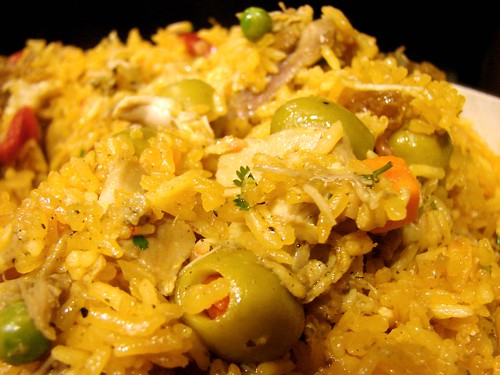
Then there will be Tamales. Whether they’re filled with chicken, pork, seafood or a combination of all of those, you will find these at your Tia’s table. I love these so much, I need to make another batch. You can too, just click this link for the recipe, the food shots are here.
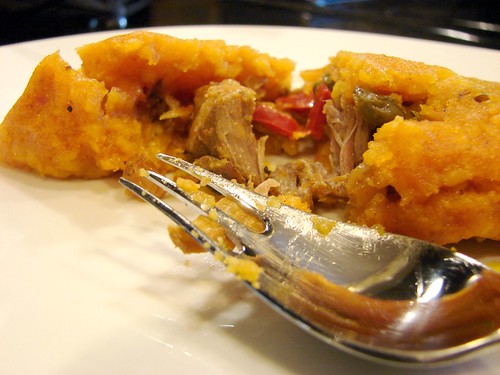
What is always present on your holiday table?
You can find the original recipe to this delicious mole on Rick Bayless’ site or, as I did, on this cookbook. The full version of the recipe includes all the peppers that need to be roasted, rehydrated and blended. I took a shortcut here. Instead of using the various peppers (chiles), I went for a prepared, store-bought mole under the assumption that it would include said peppers. I know. There are a few Mexican grandmothers turning in their graves as I type this. My only hope is that they don’t read English and maybe won’t understand the extent of my trespass. Move on.
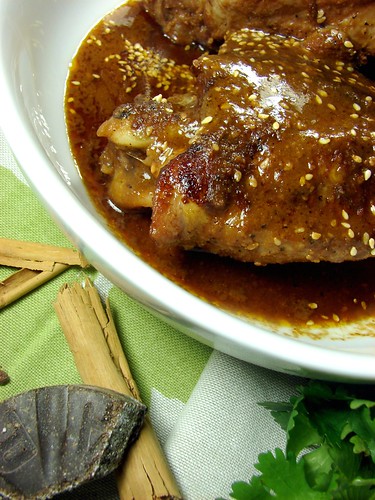
I suppose my shortcut doesn’t allow me to judge the true tastes of the original recipe, but I can tell you that shortcut or no, this recipe rocks! This stuff is so delicious, I considered bathing in it. OK, I know you don’t need that graphic ingrained to your brain. My bad. Anyway, this would be awesome on chicken, pork, seafood, coffee, cookies, eh er…

Turkey in Red Mole Sauce (adapted from Mexico – One Plate at a Time)
makes about 10-12 cups of sauce
5 medium tomatillos, husked and rinsed
1/2 cp sesame seeds
1/2 cp rich pork lard or vegetable oil (I used bacon fat)
4 garlic cloves, peeled
1/2 cp unskinned almonds
1/2 cp raisins
1/2 tsp cinnamon, (use ground Mexican canela if available)
1/4 tsp black pepper, freshly ground
1/4 tsp anise
1/8 tsp cloves
1 cp pre-packaged mole sauce
1 slice firm white bread, darkly toasted and broken into several pieces
1 oz (about 1/3 of a 3.3-ounce tablet) Mexican chocolate, roughly chopped
Salt
4 – 5 tbsp sugar
4 turkey thighs with skin & bones (approx 4lbs)
And now, for the steps:
Roast the tomatillos under a very hot broiler until splotchy black and thoroughly soft, about 5 minutes per side. Scrape into a large bowl.

In a dry skillet over medium heat, toast the sesame seeds, stirring nearly constantly, until golden, about 5 minutes. Scrape half of them in with the tomatillos. Reserve the remainder for sprinkling on the turkey.
In a heavy-bottom pot or dutch over or Mexican cazuela, if you have one of those, heat the bacon fat over medium heat and fry the garlic and almonds, stirring regularly, until browned (the garlic should be soft), about 5 minutes. With a slotted spoon, remove to the tomatillo bowl, draining as much fat as possible back into the pot.
Add the raisins to the hot pot. Stir for 20 or 30 seconds, until they’ve puffed and browned slightly. Scoop them out, draining as much fat as possible back into the pot, and add to the tomatillos. Set the pan aside off the heat.

To the tomatillo mixture, add the cinnamon, black pepper, anise, cloves, bread, mole sauce and chocolate. Add 2 cups water and stir to combine.
In two batches, blend the tomatillo mixture as smoothly as possible (you may need an extra 1/2 cup water to keep everything moving through the blades), then strain it into a bowl and set aside.
If you’re using uncooked turkey, this is when you will season the turkey with salt & pepper. Raise the temperature on the pan to medium-high and brown the thighs on all sides, this will take about 10 minutes. If you make the mole sauce ahead, you can move on to braising the thighs in the sauce. If you are still working on the sauce, go ahead and put the turkey in the fridge while the sauce gets ready.
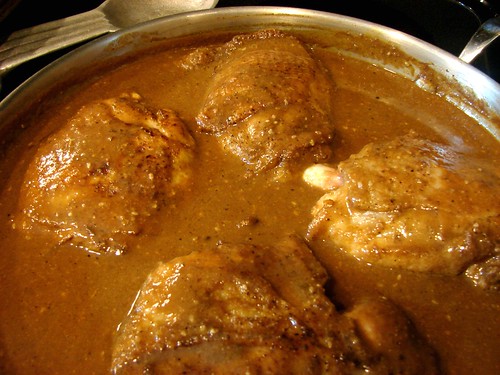
Pour out any excess fat, you only need enough to leave a film on the bottom of the pan. Add the blended tomatillo mixture and cook, stirring every few minutes until considerably darker and thicker, 15 to 20 minutes. You’re looking for the sauce to become the consistency of tomato paste. A word to the wise, use a spatter screen, this mole business is very spitty.
Add 6 cups of water to the pot and briskly simmer the mixture over medium to medium-low heat for 45 minutes for all the flavors to come together and mellow. If the mole has thickened beyond the consistency of a cream soup, stir in a little water. Taste and season with salt and sugar.
Heat the oven to 325°. Lay the turkey in the mole, cover with a lid or foil and place in the oven. Cook until the thighs internal temperature registers 150, this will take about 40-55 minutes. Remove the turkey from the sauce and allow it to rest for a few minutes. Serve with generous amounts of mole sauce.
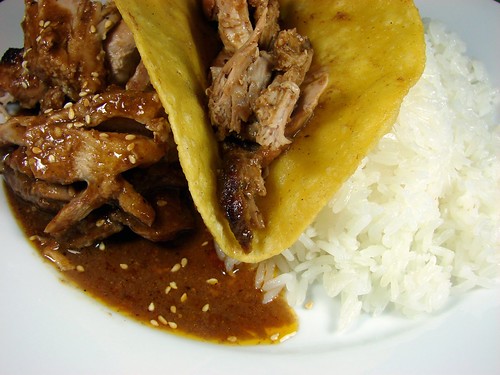
Check out the green mole here and for the rest of the mole porn shots, click here.
Cookingly yours,
Anamaris
This is the fresh mole, that’s what I’m calling it because of A tangy, tomatillo-based sauce, thickened with toasted pumpkin seeds, it’s served with everything from chicken to fish and seafood.
Again, the recipe is based on Rick Bayless’ book, Mexico-One Plate at a Time, I only substituted turkey for chicken. The recipe is pretty straightforward, though there are a few steps to follow. As with the recipe for red mole, you can substitute uncooked turkey with your cooked leftovers. Simply prepare the sauce to completion, then add the cooked meat to heat through.
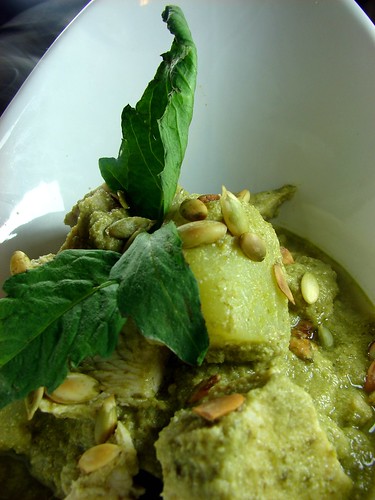
Pavo en Pipián Verde
1 turkey breast or 4 thighs (about 4lbs)
1 small white onion, sliced, divided use
4 garlic cloves, peeled and halved, divided use
1/2 tsp each dried marjoram and thyme
3 bay leaves
Salt to taste
1-1/4 cps hulled, untoasted pumpkin seeds
5-6 medium tomatillos, husked, rinsed and roughly chopped
2 large romaine lettuce leaves, torn into large pieces
2 serranos or 1 jalapeño, stemmed, roughly chopped
Leaves from a small sprig of epazote, plus an additional sprig for garnish
1/2 cp loosely packed chopped cilantro, plus a few sprigs for garnish
1-1/2 tbsp vegetable oil or olive oil
2 medium chayotes
2 medium zucchini
Poach the turkey: In a stock pan, add 10 cups water, half onion, 2 garlic cloves, marjoram, thyme, bay leaves and about 1-1/2 teaspoons salt. Bring to boil. Add the turkey, reduce heat to simmer. Simmer uncovered over medium heat for 20 minutes. Cover pot and let stand off heat for another 30 minutes. Remove turkey from pot. Strain broth and skim off fat that rises to top (can be done 1 day ahead).
Prepare sauce: In a saucepan, Dutch oven or cazuela (a traditional Mexican earthenware casserole with a lid), dry-toast pumpkin seeds. Set pot over medium heat, add the seeds and, when the first seed pops, stir constantly until all have popped from flat to round, about 5 minutes. Don’t let them darken past golden or the sauce will be brownish and slightly bitter. Cool. Set aside 3 tablespoons for garnish and transfer rest to blender.

Add remaining onion and garlic to blender, along with tomatillos, lettuce, chiles, epazote leaves and chopped cilantro. Pour in 1 cup of strained broth; cover and blend to smooth puree (can be done 1 day ahead).
 In In the same pot you toasted the seeds, heat oil over medium-high heat. When hot enough to make a drop of puree sizzle sharply, add it all at once. Stir as mixture darkens slightly and thickens considerably, about 10 minutes. Stir in 2 more cups broth, reduce heat to medium-low and simmer about 20 minutes for flavors to mellow and sauce to thicken to medium consistency (it should coat spoon). Be careful, this is another spitty sauce.
In In the same pot you toasted the seeds, heat oil over medium-high heat. When hot enough to make a drop of puree sizzle sharply, add it all at once. Stir as mixture darkens slightly and thickens considerably, about 10 minutes. Stir in 2 more cups broth, reduce heat to medium-low and simmer about 20 minutes for flavors to mellow and sauce to thicken to medium consistency (it should coat spoon). Be careful, this is another spitty sauce.
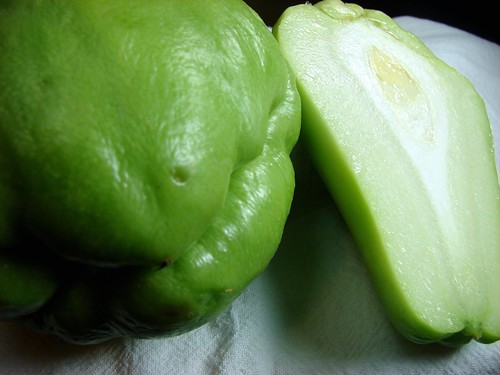
While sauce is simmering, prepare the veggies. Peel the chayote and remove the seed. You may want to do this under running water as chayote has a sap that will stick to your hands and make them turn black. Cube the chayote after peeled, then blanch the vegetables in salted boiling water, cooking chayote about 3 minutes, then adding zucchini for 1 minute. Drain and spread vegetables on plate to stop cooking.
When sauce has simmered 20 minutes, it will likely look coarse. Smooth it to a velvety texture by reblending it in small batches (loosely covered to avoid blender explosions). Return sauce to pan, taste and season with salt, if needed, about 3/4 teaspoon. If sauce has thickened beyond a light cream-sauce consistency, thin it with a little remaining broth.
Remove skin from cooked turkey, if desired, cube and slip into sauce, then add cooked vegetables. Simmer over medium heat just long enough to heat everything, about 5 minutes, then spoon turkey, vegetables and sauce out onto warm serving platter. Sprinkle with reserved pumpkin seeds (you may want to crush them), decorate with sprigs of epazote and cilantro.

For the full mole action, check out the photostream.
Cookingly yours,
Anamaris
I’ve never made mole before. Not really. I wanted to share these recipes with you so you’d have something to work with for Turkey’s Day After. It’s impossible to avoid having 100 lbs of leftover turkey and you can only eat so many sandwiches.
Let me try to describe the flavors of these dishes to you and do them justice. I’ll start by saying they’re similar in the complexity of flavors, at once surprising and familiar. Yet, they’re also in perfect contrast to each other.
Red mole seemed to have an inherent nuttiness that reminded me of peanut butter and the slightly bitter sweetness of chocolate. There’s smokiness that makes you wonder if this is a sauce that was developed from an old roux. It is rich and spicy, not in term of heat but flavor. Yet, it doesn’t taste like 5 different spices, they’re not individually identifiable, but you can tell they’ve come together to bring out the best in each other.

On the other hand, the pipián sauce or green mole tasted light and vibrant, with a nice pungent bite. The lightness of it seeming to fight against the creaminess of the sauce. I’m not sure how to explain it, other than to say it tasted as though we were eating something rich and decadent, while knowing nothing heavy or rich was added.

I’m not going to lie and say these are easy recipes, but they were not too difficult either. Scratch that. They’re not difficult at all, what they are is involved. Lots of steps, which is why I cheated a bit. We have 2 versions of the traditional Mexican sauce: Turkey in Mole Rojo and Turkey in Pipián Verde (green mole).
These recipes come from Bayless’ cookbook, Mexico – One Plate At A Time, and you’ll notice there is at least one other post in the last few days that was inspired by the book. Check out the Green Beans & Carrots in Escabeche. They are incredibly delicious.
A couple of side notes:
- The website recipe is for a very large batch, it’s actually doubled the one in the book. I don’t think you’re feeding a small army, so I’m offering the book version. I had enough sauce to save about 4-6 cps for later use.
- Bayless calls for a whole boneless turkey breast (uncooked). Since I’m not a breast fan, I went with thighs and kept the bones in the mix.
- If you are making this with leftover turkey, simply add the cooked meat once the sauce has reduced.
- I have an old, kick-ass blender that can puree almost anything to a pulp. This is to say I skipped the straining part, you may need to strain it if your blender doesn’t do as well and/or if you have issues with tidbits of sesame seeds.
- Use an oven-safe pan or dutch oven. You will cook on the stove and finish it in the oven.
Are you ready for this? Check out the recipe posts, Turkey in Red Mole and Turkey in Pumpkin Seed Sauce.
Panamá, being the proverbial melting pot, has an incredibly abundant Chinese presence. You can’t walk more than a few yards before stumbling into a Chinese restaurant or a corner tienda, a little neighborhood store where you can buy everything from fresh bread to pigs feet and a hammer. That means Chinese food has been influenced by the local’s taste buds and available produce. Chinese food in Panama is completely different from Chinese food in Houston and Houston’s is nothing like Chinese food in NYC. Adaptability. I often wonder if I would enjoy Chinese food in China. But I digress.
I’ve shared with you a recipe for roast chicken very popular in Latin America. This is pretty much the same thing with a few changes and the addition of this ketchupy sauce added to chicken in Panamá. I don’t know what it is about this simple sauce, but it would probably fall under the Chino-Latino category. Almost every Chinese restaurant in Panama will offer some version of this rotisserie chicken and BBQ pork, which is absolutely divine.
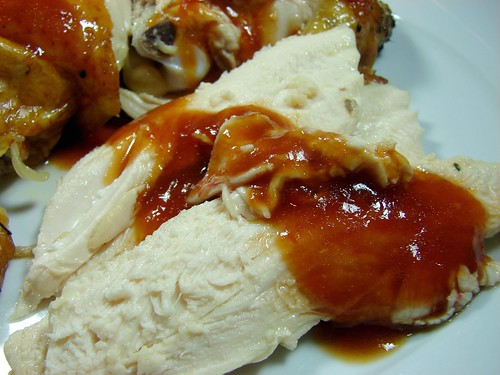
The chicken is seasoned pretty much the same, then roasted to golden perfection and served with the yummy sauce all over it. To ensure the chicken is super juicy, I brined it for just over an hour, ideally, I would’ve allowed it to brine longer, but it was still delicious. It occurs to me that this would also work brilliantly with turkey, I may just give it a try. Here’s what you’re looking for.
Pollo Panamá
1 whole chicken, approx 4-6 lbs
For the brine:
2 Sazón packets
4 garlic cloves, crushed
4 tbsp soy sauce
2 tsp sea salt
2 tbsp Italian seasoning
2 tbsp sugar
Water
Chino-Latino Ketchup
1/2 cp ketchup
1-1/2 tbsp soy sauce
1-2 tsp sugar
1/4 cp water
Habanero hot sauce, to taste
1 garlic clove, halved
2 tsp extra virgin olive oil
For the chicken: Heat about 1/2 cp of water and add the garlic, salt, Italian seasoning and sugar for the brine, allow it to come to a quick boil, then turn off and transfer to a bowl large enough to submerge the chicken. Or you can use a large ziploc bag. Give it just a couple of minutes to cool, then add the rest of the brine ingredients.
In the meantime, remove the giblets from the chicken’s cavity and rinse the chicken under cool water. Drain and place the chicken in the bowl with the brine concentrate and fill the bowl with enough water to submerge the chicken. Allow the chicken to marinate in the brine for about an hour, longer if you have the time.

Preheat oven to 350°. Prepare a roasting pan and rack large enough to hold the chicken. Drain the chicken and pat it dry. Rub it with extra virgin olive oil and place on the rack breast side down. I prefer to roast whole chickens and turkeys with the breast down to make sure it is juicy, since breast isn’t my favorite meat. If you’d rather have pretty skin on the breast, then roast it breast side up. Place the chicken in the preheated oven and allow it to roast for about 20 minutes per pound, for a 5-pounder, you’re looking at just under 2 hours.
Note: I will usually roast the chicken or turkey at 375° for about 10 minutes, then lower the temperature to 350° for the remainder of the roasting time, but I was being very lazy with this chickie. You know what? It was still perfect!
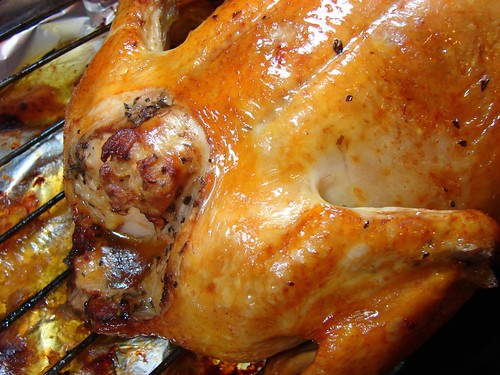
Once the internal temperature reads somewhere around 180°-185°, remove the chicken from the oven and cover loosely with foil. Allow it to rest to allow the juices to redistribute and make Ms. Chickie very happy. This is a good time to put the sauce together if you haven’t already.
In a small saucepan, heat a bit of olive oil and add the garlic halves allowing them to permeate the oil for a minute or two. Add the rest of the ingredients, tasting it after the first teaspoon of sugar, this should be to your taste. Adjust the seasoning with salt, if necessary, but the soy should take care of it. Bring it to a slow simmer for 5 minutes or so, keep it warm and spoon over the chicken to plate.
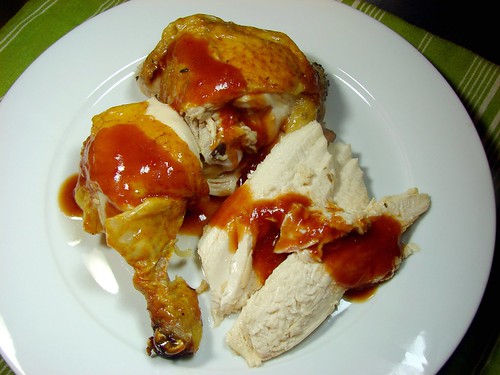
Check out the photo set for more juicy shots.
Cookingly yours,
Anamaris
For some beer!
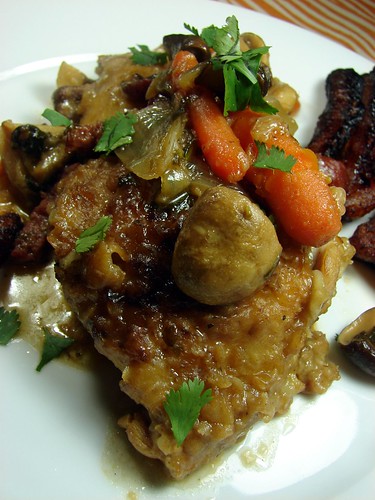
OK, I have to admit I don’t quite get the chicken jokes. Or the knock-knock ones, must have something to do with cultural differences, but I had to give it a try. I’m supposed to always use a catchy title, not that I think this one was, but I’m trying.
A few days ago, Tyler Florence was making the ultimate Coq au Vin and it looked amazing as most of his ultimate dishes do. So I started thinking how I could bring it to Latin territory and this is what I came up with. Coq au Biere: Chicken in beer. This was oh so delicioso! It got better day after day; day 1 was awesome, but day 3 was beyond words.
I really liked the way the beer just mellowed out and became earthy, smoky and slightly sweet as it cooked into the sauce. I originally served it with very ripe, fried plantains or tajadas. I wanted to compliment the flavors of the chicken and beer with the sweetness of the plantains. On days 2 & 3 I served it with white rice to really benefit from the flavors in the sauce. I hope you will give this one a try, it is pretty easy to put together.
Chicken in Beer
8-10 chicken thighs
All purpose flour (for dredging)
2 tsp sea salt
1-1/2 tsp black pepper
2 cloves garlic, pureed
2 tbsp vegetable oil
3-4 Spaish chorizo links, sliced (or bacon)
2 cps onions, chopped
2 cps mushrooms
2 cps carrots, chopped
1/4 cp sherry or white wine
1 bottle medium dark ale (like Negra Modelo, Shiner)
2 cps fresh cilantro, chopped
1 tsp herbs de Provence
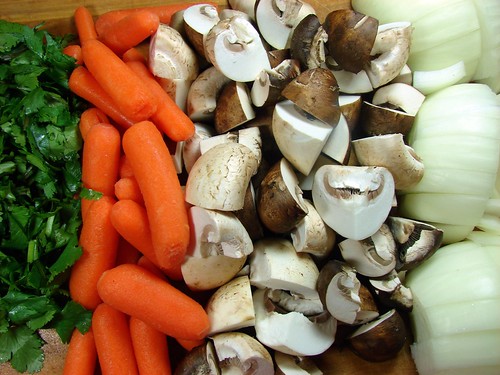
Season the chicken with salt, pepper and garlic puree, set aside. Combine flour with a pinch of salt and pepper and use it to coat/dredge the chicken pieces. Reserve 1-2 tbsp of the flour. Meanwhile, heat the oil in a large, heavy skillet over medium high heat and brown the chicken pieces on both sides. Set aside.
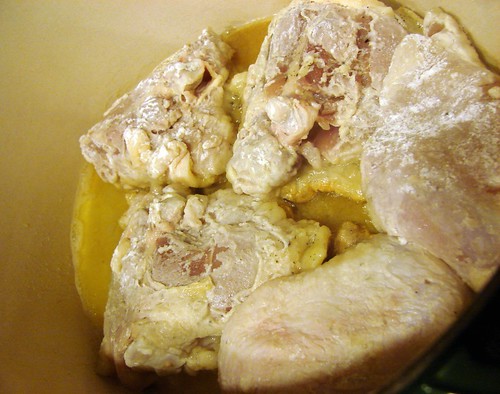
Remove the excess oil and cook the chorizo in the same skillet. Then add the onions, cooking until softened. Add the mushrooms and carrots, and allow to cook until the vegetables have softened. Add the cilantro and Herbs d’Provence, once mixed in, add the reserved flour and allow it to cook for a couple of minutes.

Pour the sherry and allow it to cook down over high heat. Then stir in the beer and broth.
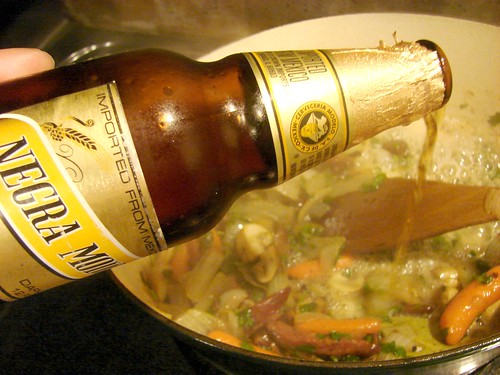
When the beer is well blended, add the chicken pieces and any juices that drained from the chicken. Cover and simmer for about 1 hour. Remove the lid and continue to simmer for 15 minutes to allow the sauce to reduce a bit.
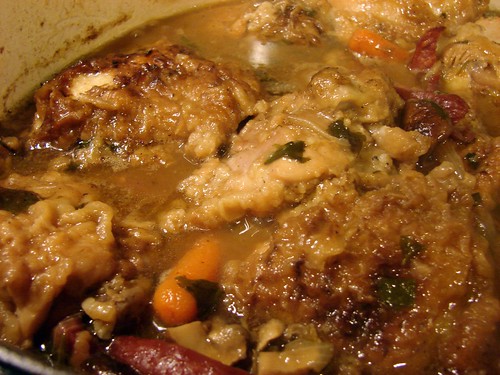
That’s it! Serve with fried tajadas and or rice.

Cookingly yours,
Anamaris
